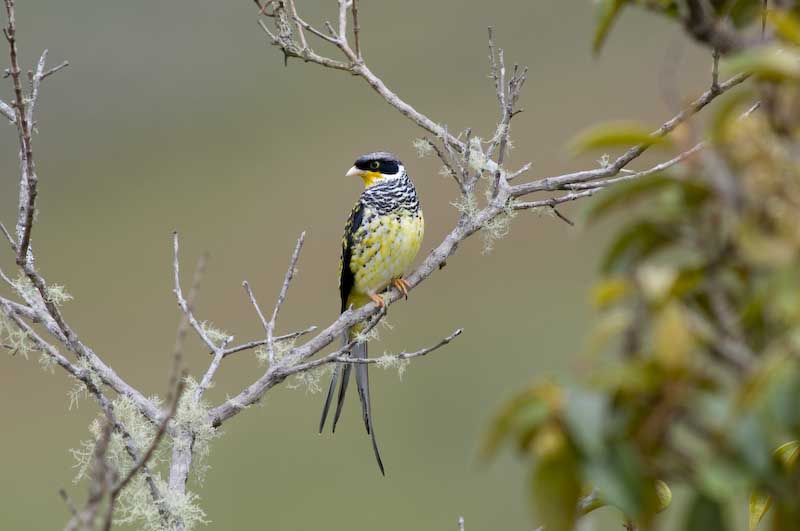Bolivian Andean Cerrado
by Bennett
Hennessey and Martin Berg
 This habitat is only found in the flat plains in the Apolo region of Boliviia with the flagship species being the Bolivian endemic Palkachupa Cotinga. The best protected area of this habitat is around the indigenous village of Aten, which holds the largest population of the Palkachupa Cotinga.
Around Aten you can find many of the other Bolivian Andean Cerrado species species (see Aten area bird list). The Green-capped Tanager has been found around Aten as well. From Aten, fallow the road away from the village to a lush Yungas cloud forest, perfect for an afternoon of biring. William Ferrufino runs the Asociacion Armonia Palkachupa Cotinga conservation program in Aten. Search for him to see about local guiding for the species and to visit Armonia's Palkachupa Reserve. This habitat is only found in the flat plains in the Apolo region of Boliviia with the flagship species being the Bolivian endemic Palkachupa Cotinga. The best protected area of this habitat is around the indigenous village of Aten, which holds the largest population of the Palkachupa Cotinga.
Around Aten you can find many of the other Bolivian Andean Cerrado species species (see Aten area bird list). The Green-capped Tanager has been found around Aten as well. From Aten, fallow the road away from the village to a lush Yungas cloud forest, perfect for an afternoon of biring. William Ferrufino runs the Asociacion Armonia Palkachupa Cotinga conservation program in Aten. Search for him to see about local guiding for the species and to visit Armonia's Palkachupa Reserve.
 Birding in the area should be started along the road that runs along the hill ridge south of the village. The road gives a fantastic view of the landscape and during clear days with the snow capped Andes as stunning scenery. Good selection of savannah birds is to be found here. The Palkahupa Cotinga should be found relatively easy during breeding season but harder during the rest of the year. Search fruiting trees and for the Swallow Tanager which are often together. During Martin's time in Aten he noticed that the same roosting tree is used most nights. Green-capped tanager is also found in this area, but hard to find. Search along the hill ridge in lower isolated trees and bushes. Birding in the area should be started along the road that runs along the hill ridge south of the village. The road gives a fantastic view of the landscape and during clear days with the snow capped Andes as stunning scenery. Good selection of savannah birds is to be found here. The Palkahupa Cotinga should be found relatively easy during breeding season but harder during the rest of the year. Search fruiting trees and for the Swallow Tanager which are often together. During Martin's time in Aten he noticed that the same roosting tree is used most nights. Green-capped tanager is also found in this area, but hard to find. Search along the hill ridge in lower isolated trees and bushes.
Depending on the morning’s success either spend the afternoon in the same area to search Green-capped tanager or move down to the nearby Yungas forest.
Specialties: Palkahupa Cotinga, Green-capped tanager
Others: Red-winged tinamou, Solitary eagle, Scissor-tailed nightjar, Burrowing owl, White-eared puffbird, Rufous-browed peppershrike, Emerald toucanet
Yungas of Aten, by Martin Berg
Not more then 6 km along the road south of Aten some good Yungas forest are to be found. The elevation is between 1000-1200 m a.s.l. and provides a good selection of both lowland and Yungas species. There are no trails in this area but the road provides excellent opportunities for birding. Simply begin at the highest part of the Yungas forest in predawn and slowly work your way down until you reach new savannah fragments some 5 km lower down along the road.
Mixed species flocks often feed in the forest edge along the road and the many outlooks views the steep hillsides and canopies. During noon breeding season Palkachupa cotingas have been seen flying down in this valley from the savannah. An evening or early morning visit can result in two species wood-quails, hooded tinamou and the rare pavione cuckoo. Ashy antwren has been seen in the upper part of the valley as well as chestnut-crested cotinga.
The western valley (B) is much better for Yungas species and generally better birding area then the eastern valley (C- in bird list). I believe that the lowest part of the western valley (not surveyed) may hold some lowland species not to be found anywhere else in the Apolo area.
Even if birding is good here I recommend one morning in this area.
Specialties: Yungas Antwren, Chestnut-crested cotinga, Stripe-faced wood-quail
Others: Hooded tinamou, Black-and-chestnut eagle, Toco Toucan and a vide range of lower Yungas species
Logistics: First you need to get to Apolo. You could try reaching the site with a rented car (from La Paz- no car rental in Apolo), rent a local Apolo motorcycle (if possible), or get a taxi to drop you off, and pick you up at the end of the day (paying a good rate, with withheld payment until pickup- negotiate all this way before hand). There is next to no traffic on this dirt road. |

